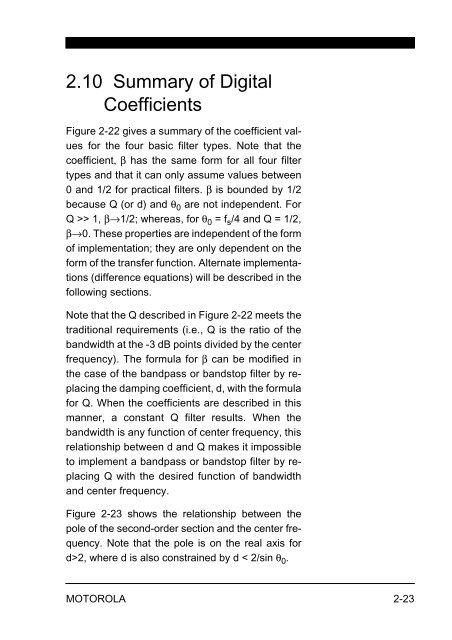Implementing IIR/FIR Filters
Implementing IIR/FIR Filters
Implementing IIR/FIR Filters
You also want an ePaper? Increase the reach of your titles
YUMPU automatically turns print PDFs into web optimized ePapers that Google loves.
2.10 Summary of Digital<br />
Coefficients<br />
Figure 2-22 gives a summary of the coefficient values<br />
for the four basic filter types. Note that the<br />
coefficient, β has the same form for all four filter<br />
types and that it can only assume values between<br />
0 and 1/2 for practical filters. β is bounded by 1/2<br />
because Q (or d) and θ 0 are not independent. For<br />
Q >> 1, β→1/2; whereas, for θ 0 = f s /4 and Q = 1/2,<br />
β→0. These properties are independent of the form<br />
of implementation; they are only dependent on the<br />
form of the transfer function. Alternate implementations<br />
(difference equations) will be described in the<br />
following sections.<br />
Note that the Q described in Figure 2-22 meets the<br />
traditional requirements (i.e., Q is the ratio of the<br />
bandwidth at the -3 dB points divided by the center<br />
frequency). The formula for β can be modified in<br />
the case of the bandpass or bandstop filter by replacing<br />
the damping coefficient, d, with the formula<br />
for Q. When the coefficients are described in this<br />
manner, a constant Q filter results. When the<br />
bandwidth is any function of center frequency, this<br />
relationship between d and Q makes it impossible<br />
to implement a bandpass or bandstop filter by replacing<br />
Q with the desired function of bandwidth<br />
and center frequency.<br />
Figure 2-23 shows the relationship between the<br />
pole of the second-order section and the center frequency.<br />
Note that the pole is on the real axis for<br />
d>2, where d is also constrained by d < 2/sin θ 0 .<br />
MOTOROLA 2-23
















